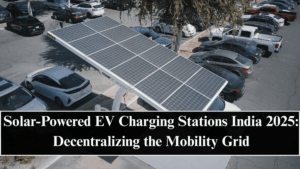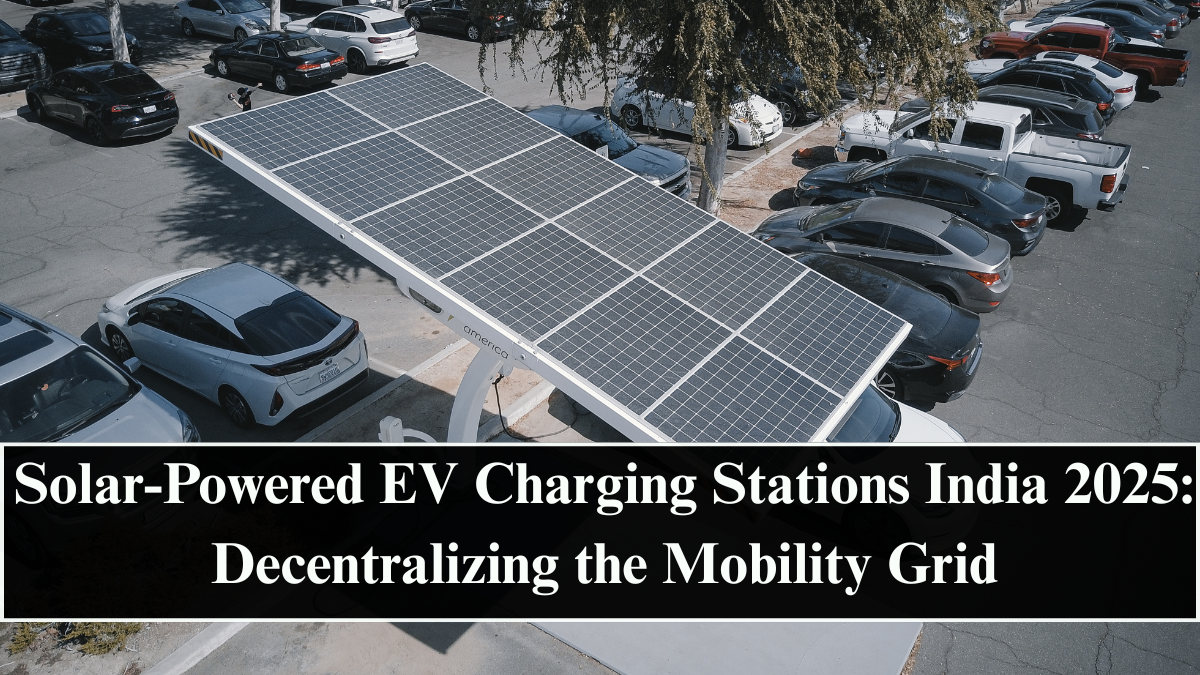India’s EV revolution is now powered by the sun. With Solar-Powered EV Charging India 2025, the country is reshaping how vehicles are fueled — using renewable, decentralized, and self-sustaining energy systems that merge solar power with electric mobility.
As EV adoption rises sharply across cities and highways, the focus has shifted toward off-grid charging solutions that reduce dependence on coal-based electricity and the central power grid. Solar charging hubs are emerging as the cornerstone of India’s sustainable mobility ecosystem.

The Need for Solar-Powered EV Infrastructure
While EV sales in India have crossed record numbers in 2025, one major challenge remains — the strain on the national grid. Traditional charging stations consume large amounts of power during peak hours, often leading to localized load imbalances.
Solar-based charging offers a cleaner, smarter solution. By harnessing renewable energy, these systems enable 24/7 charging independence, especially in remote or semi-urban areas. They also align with India’s Net Zero 2070 commitment, drastically reducing lifecycle emissions associated with electric mobility.
In addition, solar-powered charging reduces long-term operational costs and enables energy resilience, ensuring charging continuity even during grid failures.
How Solar EV Charging Stations Work
A typical solar-powered EV charging setup integrates:
-
Photovoltaic (PV) panels that capture solar energy and convert it into electricity.
-
Battery Energy Storage Systems (BESS) to store excess energy for nighttime or cloudy conditions.
-
Smart inverters that regulate power flow between solar panels, storage, and EV chargers.
-
IoT-based monitoring systems that track generation, consumption, and grid interaction.
These stations operate in three models:
-
Off-Grid Systems — completely solar-dependent, ideal for rural and highway use.
-
Hybrid Systems — use solar as primary energy with grid backup.
-
Grid-Connected Systems — feed surplus solar power back to the grid through net metering.
India’s Progress in Solar EV Charging Networks
India is witnessing an aggressive rollout of solar-integrated charging infrastructure in 2025. Organizations such as Tata Power, NTPC, Servotech Power Systems, and IOCL are leading large-scale installations across highways, malls, and housing societies.
The National Highway for Electric Vehicles (NHEV) project has already commissioned solar-powered charging stations along the Delhi–Agra–Jaipur corridor, providing high-speed 120kW chargers powered by hybrid solar arrays.
States like Gujarat, Rajasthan, and Maharashtra — with high solar potential — are turning into key hubs for EV-solar convergence, offering financial incentives for renewable-powered charging infrastructure.
Economic and Environmental Benefits
Solar charging not only supports sustainability goals but also delivers strong economic advantages.
-
Lower Operating Costs: Once installed, solar systems can cut electricity bills by 60–80%.
-
Reduced Carbon Emissions: Each solar EV station offsets 40–50 tonnes of CO₂ per year.
-
Energy Independence: Eliminates reliance on volatile fossil fuel and grid-based electricity prices.
-
Revenue Potential: Excess energy can be sold back to the grid or supplied to nearby facilities.
For EV fleet operators, this model enables predictable long-term energy pricing and improved ROI through lower cost per charge.
Technological Innovations and Smart Integration
Modern solar EV stations are being enhanced with AI, IoT, and blockchain technologies to optimize performance and transparency.
-
AI-based predictive analytics forecast sunlight availability and schedule charging accordingly.
-
IoT integration allows remote monitoring, dynamic load balancing, and real-time pricing.
-
Blockchain-led energy trading platforms are enabling peer-to-peer (P2P) energy sharing among solar-powered chargers and microgrids.
Additionally, the adoption of bi-directional charging (V2G) technology allows EVs to return unused power to the grid, creating a two-way flow of clean energy.
The Road Ahead: A Decentralized Mobility Grid
By 2025, India’s push for Solar-Powered EV Charging is creating a decentralized and democratized energy ecosystem. Thousands of stations are being built across highways, residential complexes, and rural zones — reducing charging anxiety and promoting renewable adoption.
The next frontier involves portable solar chargers, foldable PV panels, and solar carports for personal and commercial use, making energy generation as mobile as the vehicles themselves.
As India’s EV journey accelerates, solar energy will remain at its core — ensuring every kilometer driven is powered by clean, renewable sunlight.
FAQs
What are solar-powered EV charging stations?
They are charging systems that use solar panels to generate electricity for charging electric vehicles, reducing grid dependence and emissions.
Are solar EV chargers viable in Indian weather?
Yes. India receives abundant sunlight year-round, making solar charging both practical and cost-effective.
How do solar charging stations work at night?
They use battery storage systems that store excess energy generated during the day for nighttime charging.
Which companies are building solar EV chargers in India?
Tata Power, Servotech Power Systems, NTPC, and IOCL are leading the development of solar-integrated EV stations.
What is the future of solar EV charging in India?
A nationwide decentralized network of solar-powered chargers will support clean, affordable, and grid-independent mobility by 2030.
Click here to know more.
